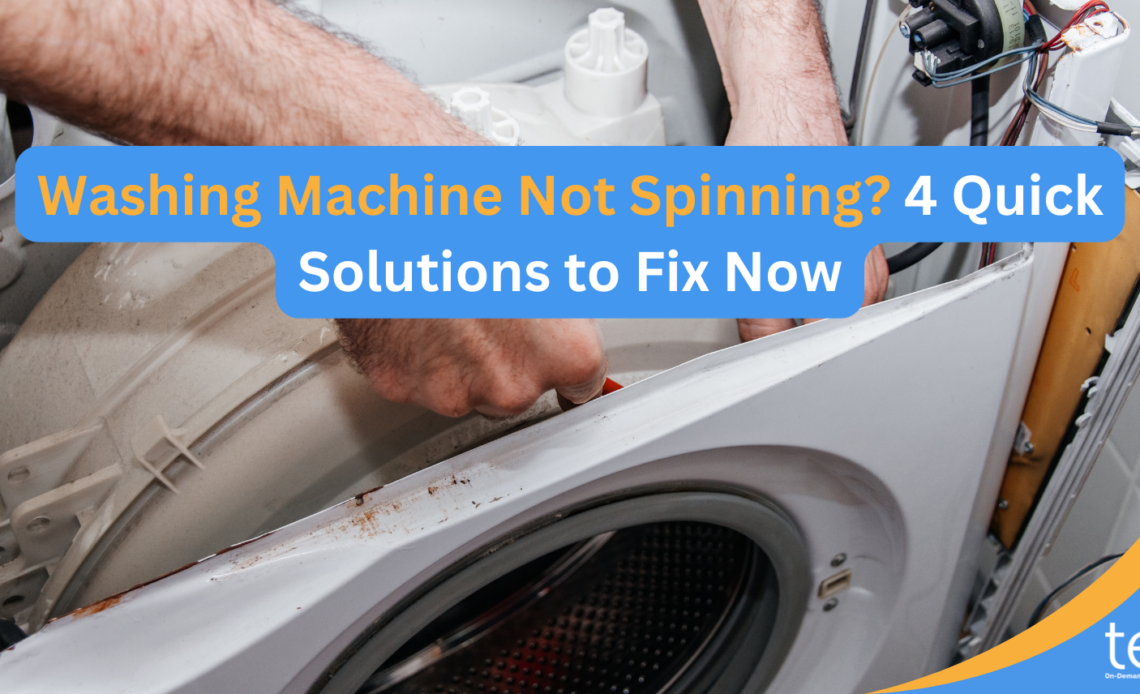Have you ever found yourself frustrated with a pile of wet clothes because your washing machine isn’t spinning fast enough? It’s a common problem that can turn laundry day into a real headache.
You rely on your washing machine to make life easier, so it’s no surprise that a slow spin cycle can throw a wrench in your plans. But don’t worry; you’re not alone. Many people face this issue, and it’s often easier to fix than you might think.
We’ll explore the reasons why your washing machine isn’t spinning fast and what you can do to get it back in top working condition. You’ll discover simple solutions that could save you time, money, and a whole lot of stress. Keep reading to find out how to bring the spin back to your laundry routine and reclaim your peace of mind.

Credit: www.youtube.com
Common Causes Of Slow Spinning
Have you ever found yourself impatiently waiting for your laundry cycle to finish, only to realize your washing machine isn’t spinning as fast as it should? This frustrating issue can disrupt your day and leave you with damp clothes. Understanding the common causes of slow spinning can help you troubleshoot and fix the problem efficiently. Let’s dive into some of the typical culprits behind a sluggish spin cycle.
Unbalanced Load
One of the most frequent causes of slow spinning is an unbalanced load. When clothes bunch up on one side of the drum, it can prevent the machine from spinning at its full speed. Think about the last time you tried washing a bulky blanket with a few small items; the imbalance likely caused the machine to struggle. Ensure you evenly distribute your laundry to allow for a smoother spin.
Clogged Drain Hose
If your washing machine’s drain hose is clogged, it can lead to water not draining properly, affecting the spin cycle. Picture water trapped in the machine, weighing down your clothes and slowing down the spin speed. Check for blockages in the hose and clear them to restore optimal spinning. Regular maintenance can prevent this issue from recurring.
Worn Drive Belt
A worn or damaged drive belt can also be a culprit behind slow spinning. This belt connects the motor to the drum, enabling it to spin. If the belt is loose or frayed, the drum won’t rotate efficiently. Have you ever had to replace a worn-out belt in your car? The same concept applies here. Inspect the drive belt for signs of wear and consider replacing it if needed.
Faulty Lid Switch
Did you know a faulty lid switch can prevent your washer from spinning properly? This switch acts as a safety mechanism, ensuring the lid is securely closed during operation. If it’s malfunctioning, the machine might not spin at all. Test the switch by opening and closing the lid to see if it engages the spin cycle. If it doesn’t, it might be time to replace the switch.
Addressing these common issues can significantly improve your washing machine’s performance. Have you checked your machine for any of these problems recently? Ensuring your washer spins at the right speed not only saves time but also enhances the efficiency of your laundry routine.
Diagnosing The Problem
Is your washing machine not spinning fast? This common issue can arise from several causes. Identifying the root of the problem is crucial to restoring its efficiency. Let’s explore ways to diagnose the problem.
Checking Load Balance
A misbalanced load often leads to spinning issues. Distribute clothes evenly in the drum. Avoid overloading. Heavy items can cause imbalance. Check if the machine rocks during the spin cycle.
Inspecting The Drainage System
Poor drainage affects spinning speed. Ensure the drain hose is clear. Check for blockages in the pump filter. A clogged system slows down the spin cycle. Proper drainage is essential for fast spinning.
Examining The Drive Belt
The drive belt transfers power to the drum. A worn or loose belt affects spinning. Inspect the belt for signs of wear. Replace if it’s frayed or damaged. A tight belt ensures efficient spinning.
Testing The Lid Switch
The lid switch plays a safety role. It stops the spin cycle if the lid is open. Test the switch for functionality. Listen for a clicking sound when closing the lid. A faulty switch can halt spinning.
Solutions For Slow Spinning Issues
Is your washing machine leaving your clothes sopping wet because it’s not spinning fast enough? You’re not alone! This common problem can turn laundry day into a frustrating experience. But don’t worry, there are simple solutions to get your machine back to its efficient self. Let’s dive into practical fixes that can help solve slow spinning issues.
Redistributing Laundry
Ever thrown in a heavy blanket with a few shirts and found your machine struggling? Uneven laundry distribution can cause your washer to spin slowly. Try redistributing the items evenly around the drum. A balanced load helps the machine spin more efficiently, preventing unnecessary wear and tear.
Cleaning The Drain Hose
Clogs in the drain hose can hinder your washer’s ability to spin properly. Check for any blockages, like lint or small items, in the hose. Clearing these obstructions can improve water drainage and enhance spinning speed. It’s a quick fix that often goes overlooked!
Replacing The Drive Belt
Has your washer been spinning slower over time? The drive belt might be wearing out. Inspect it for signs of damage or looseness. If needed, replacing the belt can restore your machine’s spinning power. Think of it like changing a flat tire; sometimes, a swap is all it takes to get back to optimal performance.
Repairing Or Replacing The Lid Switch
Did you know a faulty lid switch can cause spinning issues? When the lid switch is broken, the machine might not spin at all. Examine the switch for any damage or wear. Repairing or replacing it could be the solution to your spinning woes. A working lid switch ensures your machine spins safely, preventing accidental injuries.
Have you faced any of these issues before? What solutions worked best for you? Share your experiences and insights in the comments below. Your thoughts might help someone else on their laundry journey!

Credit: teko.ph
Preventive Measures
Regular maintenance can prevent a washing machine from spinning slowly. Clean the filter and check for unbalanced loads. Inspect the belt and motor for wear.
Preventive MeasuresKeeping your washing machine in top condition requires more than just using it. Implementing preventive measures can save you from costly repairs and extend the life of your appliance. Let’s dive into some practical steps you can take to ensure your washing machine spins fast and efficiently.Regular Maintenance Tips
Regular maintenance is key to a smoothly running washing machine. Clean the drum and detergent drawer every month to avoid build-up. Don’t forget to check and clean the filter regularly; a clogged filter can significantly slow down the spin cycle. A personal tip: I set a monthly reminder on my phone to check the machine’s hoses for any signs of wear and tear. This simple habit has saved me from unexpected leaks.Proper Loading Techniques
Properly loading your washing machine can make a big difference. Overloading or underloading can throw off the balance and affect the spin speed. Follow the manufacturer’s guidelines for load sizes to keep everything running smoothly. Think about your last wash. Did you stuff it to the brim? Next time, leave a little space and see the difference it makes in the spin cycle’s speed.Routine Inspections
Routine inspections can help catch issues before they become big problems. Check the drum for any loose items that might hinder spinning. Listen for unusual noises during the cycle, which could indicate an issue. Have you ever found a stray sock or coin in your machine? Regular inspections can prevent these small items from causing big headaches.Use Of Quality Detergents
The detergent you use matters more than you might think. High-quality detergents dissolve better and leave less residue, which can prevent blockages. Using the right amount is just as important to avoid build-up that could slow down your spin cycle. Next time you shop for detergent, consider choosing a brand known for quality. It’s a small investment that can pay off in the long run. Incorporating these preventive measures into your routine can keep your washing machine spinning like new. What steps will you take to ensure your machine stays in peak condition?When To Call A Professional
A washing machine that doesn’t spin fast might need a professional’s touch. Strange noises or persistent imbalance indicate deeper issues. Timely expert help prevents further damage, ensuring smooth operation.
When your washing machine stops spinning as fast as it used to, it can be incredibly frustrating. You may find yourself with sopping wet clothes or spending extra time drying laundry. While some issues can be resolved with a simple fix, there are times when calling a professional is the best course of action. Knowing when to reach out for expert help can save you time, money, and a lot of hassle.Identifying Complex Issues
Some problems with a washing machine are not straightforward. If you’ve checked the usual suspects like overloaded drum, imbalance, or clogged filters, yet the issue persists, it might be more complicated. For example, faulty wiring or a malfunctioning motor can be beyond a DIY repair. Professionals have the right tools and knowledge to diagnose and fix these complex problems efficiently. Taking on such repairs without expertise can lead to more damage. Do you really want to risk making it worse?Recognizing Safety Concerns
Safety should always be your top priority. Washing machines involve electrical components and water, a combination that can be dangerous if mishandled. If you notice burning smells, unusual noises, or water leaks, it’s time to pause and call in the experts. These signs can indicate serious issues that require specialized knowledge. Handling electrical repairs without proper training can lead to accidents. Your safety is worth more than the cost of a professional repair.Cost-benefit Analysis Of Repairs
Consider the costs involved in attempting a DIY repair versus hiring a professional. You might save money upfront by trying to fix it yourself, but what if the problem worsens? A professional can provide a clear diagnosis and offer a long-term solution. This could ultimately save you from purchasing a new machine or dealing with frequent repairs. Weighing the benefits of a professional repair over potential costs of mistakes can help you make the right decision. Isn’t it better to invest in a guaranteed fix rather than gamble on a temporary one? Knowing when to call a professional can make all the difference. With complex issues, safety concerns, and cost considerations, sometimes reaching out for expert help is the smartest move you can make. Don’t let a slow-spinning washing machine spin your day out of control!
Credit: 247homerescue.co.uk
Frequently Asked Questions
Why Is My Washing Machine Not Spinning Fast?
A clogged drain pump or belt issues can slow the spin. Check these parts.
How Do I Fix A Slow Spinning Washer?
Inspect and clean the drain pump. Replace or tighten the drive belt if needed.
Can Overloading Cause My Washing Machine To Spin Slow?
Yes. Overloading can unbalance the drum. This reduces spin speed.
Is A Faulty Motor Responsible For Slow Spinning?
Yes, a faulty motor may cause this problem. Consider professional repair.
Should I Check Washing Machine Settings For Spin Issues?
Yes. Ensure the spin cycle settings are correct. Adjust if necessary.
Conclusion
A washing machine not spinning fast can be frustrating. Identifying the issue helps fix it quickly. Common problems include unbalanced loads or a faulty lid switch. Regular maintenance can prevent many issues. Checking and cleaning parts extends your machine’s life.
Always consult the user manual for guidance. If problems persist, calling a professional can be wise. Keeping your machine in good condition saves money and time. Enjoy hassle-free laundry days with a well-maintained washer. Remember, a little care goes a long way.
